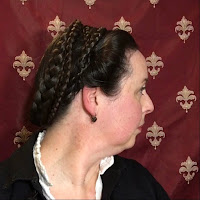Category: A garment your persona may have worn. “With silken coats, and caps, and golden rings, with ruffs, and cuffs, and farthingales, and things.”

Persona period inspiration and use:
Christian has an alter ego as the wife of a Landsknecht (German mercenary soldiers, late 15th and 16th-century). The making of personal linens for the family was traditionally a task for the woman of the household.
This shirt was undertaken as a project to while away lockdown. The shirt needs to be suitable for camping at Canterbury Faire; e.g. a high neck to protect against the sun, and minimal embellishments (e.g. embroidery) in order to be easily and repeatedly laundered.
Design, Materials and Construction:
There are no landsknecht extant shirts from this period, so the design, materials, construction, and fastening systems had to be extrapolated from extant German shirts from the late 15thC, a German child’s shirt from the early 16thC, and other men’s shirts from the early, mid, and late 16th C.
There are hundreds, perhaps thousands, of representations of landsknechts shirts in prints from the period. These images show a variety of possible shirt styles and designs (in terms of cut, fastening, embellishments etc), and details can be filled in from extant garments and images of the shirts of elite men e.g. Matthaeus Schwarz.
The linen fabric of this shirt is coarser than the fine linen that would have been used for an elite shirt. The shirt was hand sewn with linen thread; following the construction of some extent garments, the main construction seams were sewn in thicker linen thread and the finishing / detail work in finer thread.
Given lockdown resources, I had to use linen fabric ties for the neck and cuff fastenings, but these actually worked out better than expected.
Reference:
- Patterns of Fashion No. 4; The cut and construction of linen shirts, smocks, neckwear, headwear and accessories for men and women c. 1540 – 1660. Janet Arnold, 2008.
- The First Book of Fashion; The Book of Clothes of Matthaeus and Veit Konrad Schwarz of Augsburg. Editor(s): Ulinka Rublack, Maria Hayward, Jenny Tiramani, 2015.
- Textiler Hausrat, Kleidung und Textilien von Nurnberg, 1500 – 1650 by Jutta Zander-Seidel.
















